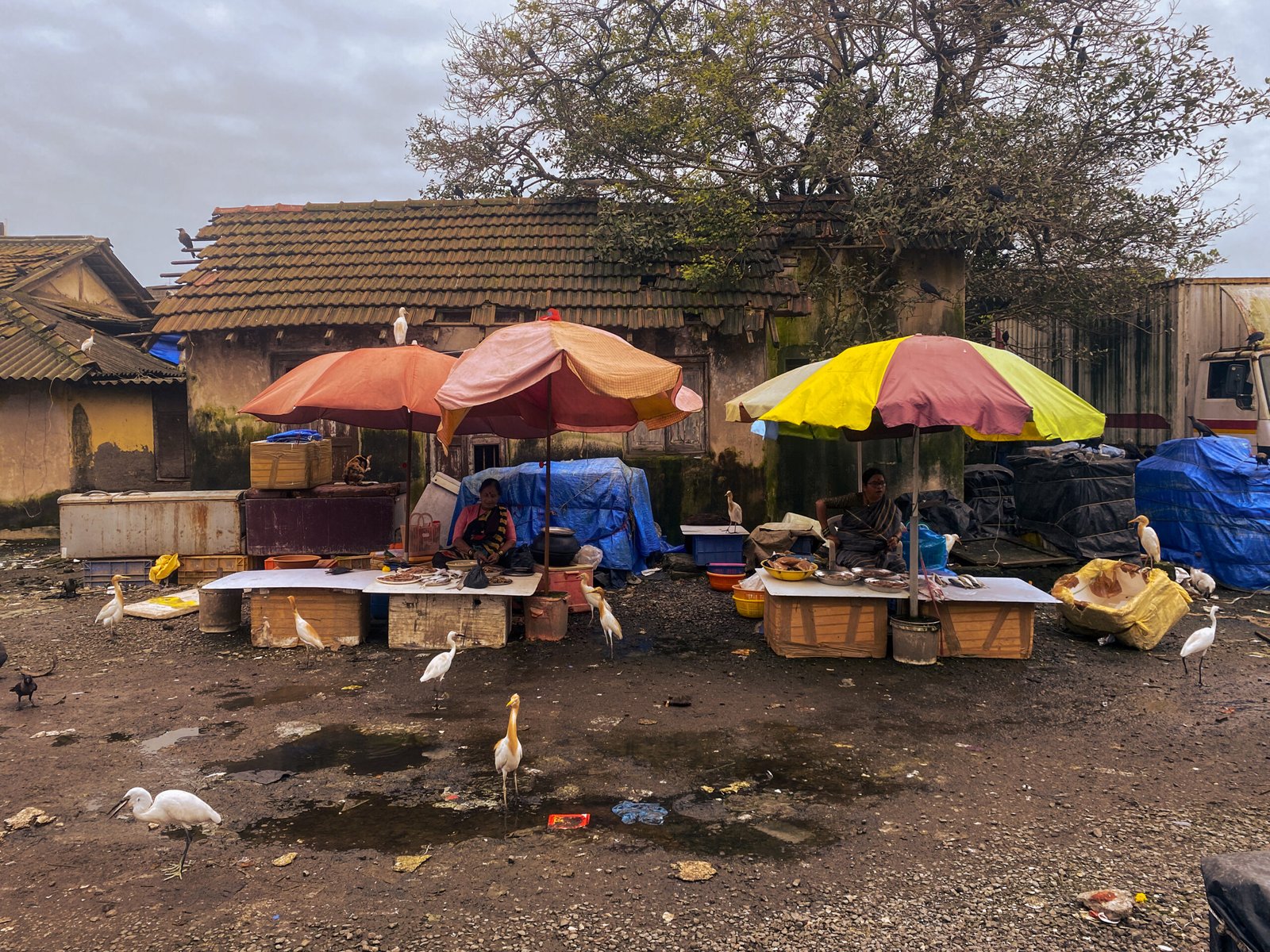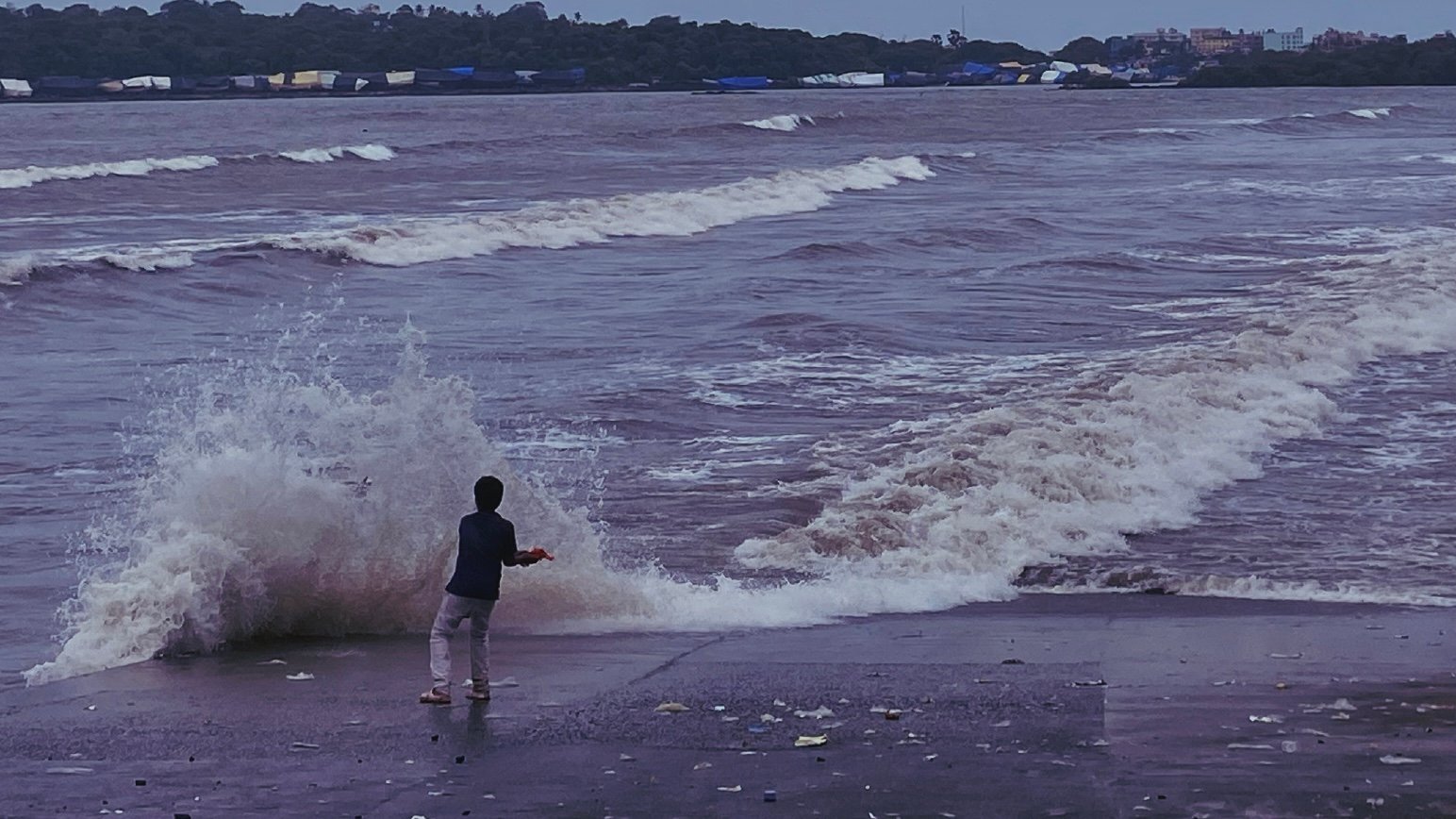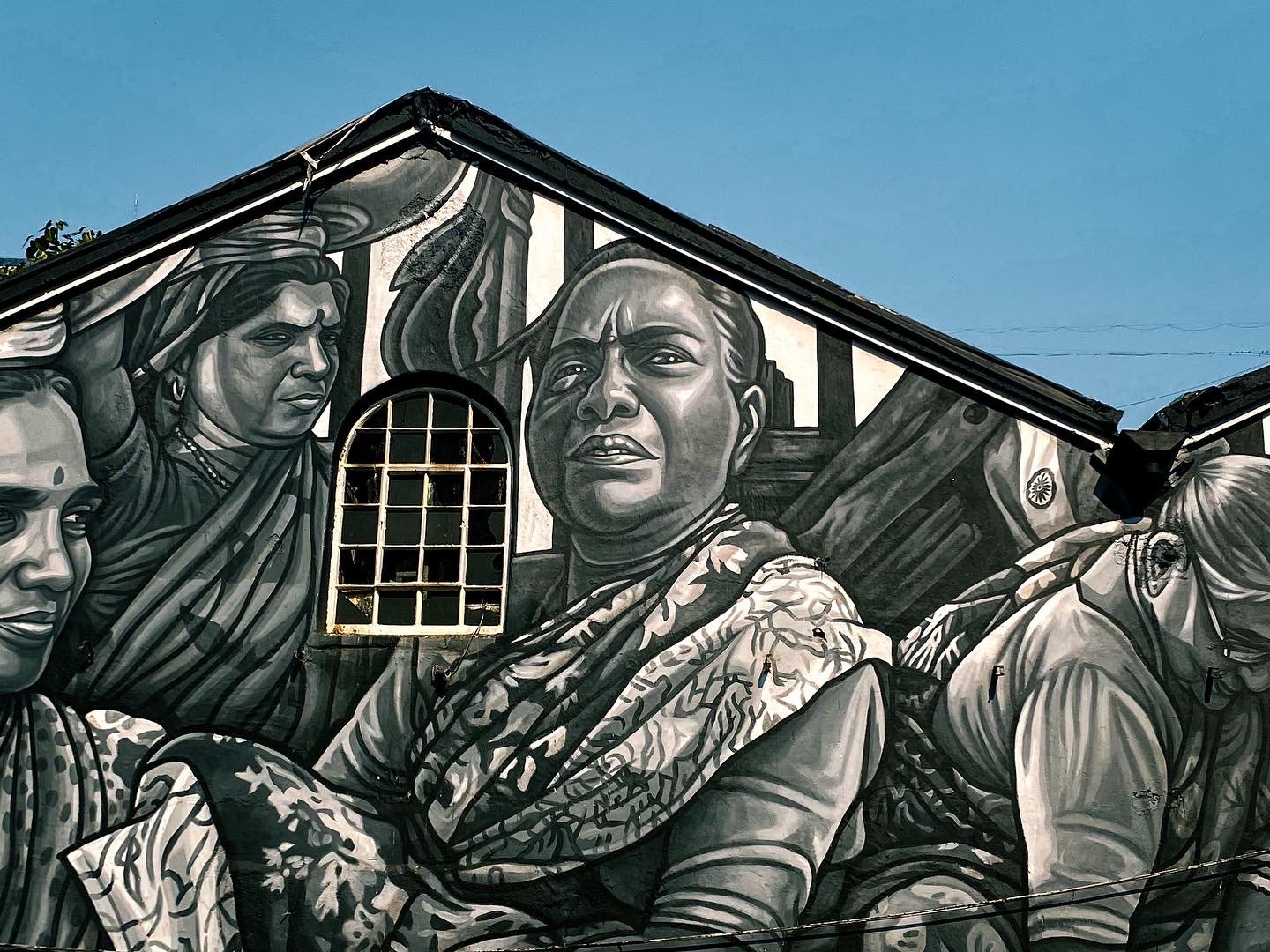“Aapke paas paanch-das minute ka time hai kya? Mujhe Sassoon Dock ke baare mein jaankaari chahiye. (Could you spare 5-10 minutes? I need some information about Sassoon Dock),” began my conversation with Asha Tai, a Koli fisherwoman, as she sat under her umbrella, swatting the flies hovering over her fish. She seemed unsure at first, but agreed to talk.
I asked her how long she had been working at Sassoon Dock for (10 years), if she had lived there her whole life (yes), and what’s the best time to go fishing in the Arabian Sea (July to October). After gauging her discomfort in Hindi through her pauses and stutters, I promptly switched to Marathi. She seemed a little more relaxed while answering now; her Koli dialect peeping through her words as she spoke.

The Kolis are a prominent indigenous community with livelihoods rooted in agriculture and fishing whose colonies – known as Koliwadas – can be found across the Indian states of Maharashtra and Gujarat. The Kolis are by no means a monolith, with many sub-groups such as Malhar Kolis, Mahadev Kolis, Son Kolis, and Dhor Kolis, with varied beliefs between Christianity, folk traditions, and worship of ancestral deities unique to their community. But the most distinct feature of their heritage is inarguably the characteristic Koli language, a potent portal to the past, carrying generations of collective memory.

The Koli language is an umbrella term describing the many tongues spoken by Koli communities across Maharashtra’s western coast. When I first overheard the Son Kolis of Mumbai speak their mother tongue, I realised that it bore some resemblance to the Konkani spoken in my home, and consisted of some commonly used Marathi words I could identify. But there was also a palpable difference in speech that could not be conflated with the more dominant neighbouring languages. It was an idiosyncratic spoken language – a recognizably different tongue with a significance of its own. It carried the crisp seabreeze of the chowpatty in its words, the saline scent of the shore in its harmonious syllables, the splash of the iridescent ocean waves against the rocks in its interjections, adorned with the glimmer of the spume, and the warmth of the sand. The Kolis carry not only their culture in their tongue; but also the living history of the last thousand decades that recounts the community’s existence on the Salcette shores. However, the fear of losing this exquisite cultural repository has started becoming more and more apparent by the day.
Recognised as the original inhabitants of Mumbai, albeit with a dwindling population, the Kolis face the relentless peril of losing their culture and languages. As waves of urbanisation loom over the quietest corners of the island city, Rupa Dongrikar, the in-charge of the Versova Koli Jamat tells us “The people of our community support the outsiders a lot, which is why they come to settle here,” referring to the suburb’s local Hingaladevi Temple.

What is known today as the vibrant upscale neighbourhood of Versova, is in reality named after the distorted English word for Vesave, which means rest or relaxation. Versova, before becoming the hectic coalesce that it is today, was the resting place of the fishermen of Bombay – as the city was known then. Interestingly, even the busy Aram Nagar, literally translates to “resting place” in English. Urban co-opting and corruption of indigenous names and terms is one of the reasons behind the gradual erasure of the Koli population. The other reason is Brahminism.
Recent calls for Marathi imposition have brought forth mixed reactions. While some express criticism and others support, most of the discourse surrounding the topic has narrowly dodged the crux of the conversation. Marathi imposition, very similar to Hindi imposition, calls for the standardisation of one specific dialect of the language, the Brahminical tongue: the Pramanbhasha. Linguistic imposition aims to homogenise a heterogeneous element; it seeks to flatten the language’s malleability, without comprehending that no single ‘pure’ language exists.
Language evolves across regions. The Marathi you would typically hear in Malvan is vastly different from the one you would hear in Khandesh, both of which are vastly different from the one you would hear in a city like Pune. Linguistic imposition champions the Pramanbhasha, requiring every marginalised group in the region to abandon their native language and adopt the oppressor’s tongue as their own, thereby leading to the death of the Bolibhasha, their spoken dialect.

Subsequently, the media adopts the oppressor’s tongue. Print, digital, and broadcast media adapts to what is seen as the “correct” Marathi, and the slightest hint at someone’s native tongue is discarded as “incorrect grammar” or mocked. Schools are instructed to teach the oppressor’s tongue, vilifying the remnants of home that linger in a child’s memory. A poem featured in my school’s Marathi textbook flashes in my mind’s eye. Aptly titled Tifan, (see below), the poem by Vitthal Wagh explores the agrarian lifestyle of a farmer, utilising a specific dialect spoken amongst the indigenous agricultural communities of Maharashtra. At the end of the page is a glossary section, “correcting” the indigenous terms with prim and proper, posh, urban, upper-caste and upper-class “grammatically correct” Marathi, subtly implying the “incorrectness” of the language of the indigenous groups.
This is not an isolated incident, it culminates into the same conversation surrounding Brahminical purity. Native groups like the Kolis are made up of several distinct groups within themselves, but are clumped into the Other Backward Classes (OBC) tag by the state. Lying at the supposed bottom barrel of the rigid caste hierarchy, everything about their culture is deemed “impure,” including their languages.
The steady death of native languages poses larger concerns when the lingua franca oppressor’s tongue has no room for them. This isn’t limited to Kolis. How can someone distill the weight of generational prejudice through the deficient funnel of Pramanbhasha, whose very existence is rooted in erasing marginalised history? How can a child from a historically oppressed group sufficiently convey the pain they have grown up seeing in their family, in a tongue that not only was forced upon them, but also created precisely to limit their expression? How can the language that the State speaks– to twist words to spell out “crime”, and actions to justify incarceration– ever make room for the historic suffering that it has never bothered to acquaint itself with?
One can define the word “displacement” in English Medium lexicon, but how can they describe it as the fuel that anti-caste poet Annabhau Sathe runs his poem Majhi Maina Gavakade Rahili on, as he recounts leaving his hometown and wife behind, migrating to Mumbai in search of employment, eventually getting subsumed in the wider debate of the Samyukt Maharashtra Movement? One can imagine the systemic plight of poverty and discrimination, but how can they explain the blood-curdling metaphor of begging a seamstress to sew back a torn life, employed in B.S. Hate’s poem Phatleli Zindagi, through the point of view of a caste-oppressed woman with no formal education? And one can envision how caste has destroyed countless lives, but can they truly grasp the horror-stricken landscape that Jyoti Lanjewar describes, regretting the very idea of birth in such a doomed atmosphere, in her poem Kashala Janmala Aalas?

What reads as “resistance” to the oppressed resounds as “terrorism” to the State; what the State dictates as “illegal” in return echoes as “survival” for the oppressed.
“The master’s tool will never dismantle the master’s house.” Audre Lorde’s quote has been reposted into oblivion on the walls of the Internet, without us ever properly gauging its real meaning. We sit back, cheering on for the oppressed to fight back in the same language that enslaves them—the same master’s tools that we somehow expect them to spearhead their resistance with.
Marathi isn’t the only factor to consider here — languages like Hindi and English are readily wiping out the existing speeches, unveiling that the task at hand isn’t limited to one hurdle.
The answer to this worry lies not only in strengthening the voices of the marginalized, but also creating spaces for these voices and languages to be heard., As Dongrikar asserts,“We are native to this city. We have been here from before the times of Chhatrapati Shivaji Maharaj, and the British, and we don’t have any plans of leaving it”
.
.
.
तिफन (Tifan) by Vitthal Wagh
काया मातीत मातीत तिफन चालते तिफन चालते
ईज नाचते थयथय ढग ढोल वाजवते
तिफन चालते
नंदी बैलाच्या जोळीले सदाशीव हकालते
वटी बांधून पोटाले पाराबती उनारते
वटी पोटाले बांधते झोयी काटीले टांगते
झोयी काटीले टांगते त्यात तानुलं लळते
त्यात तानुल लळते ढग बरसते
तिफन चालते
काकरात बिजवाई जसं हांसर चांदनं
धरतीच्या आंगोपांगी लाळानौसाचं गोंदनं
सरीवर सरी येती माती न्हातीधुती होते
तिचा कस्तुरीचा वास भूल जीवाले पाळते
भूल जीवाले पाळते वाट सांजीले पाहेते
मैना वाटूली पाहेते राघू तिफन हानते
राघू तिफन हानते ढग बरसते
तिफन चालते
वला टाकती तिफन शितू वखर पाहेते
पानी भिजल ढेकूल लोनी पायाले वाटते
काया ढेकलात डोया हिर्व सपन पाहेते
डोया सपन पाहेते काटा पायात रुतते
काटा पायात रुतते, लाल रगत सांडते हिर्व सपन फुलते
हिर्व सपन फुलते ढग बरसते
तिफन चालते


